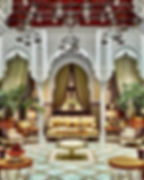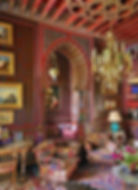The Art of Moroccan Design Aesthetics
- BAYT AL FANN
- Feb 6, 2023
- 3 min read
Moroccan design is all about colour, texture & fluid lines. It is a unique blend of North African, Mediterranean & Islamic styles, creating a distinctive look which has inspired artists & designers all over the world.

Image credit Beautiful Arab
City planning, military architecture, urban casbahs, and the intricate beauty of Moroccan carpets, woodwork, and zellij tilework are all part of this distinctive and brilliant world of art. Moroccan aesthetics continues to influence artists and designers all over the world…
Video credit: Insta Marrakech
Some of the readily recognized features of Moroccan design include Islamic geometric patterns, vivid colors, and zillij tiles. Zillij tiles are terra cotta tile-work of enamel chips set in plaster to create mosaic geometric shapes
Zillij tiles are a visual language composed of shapes, patterns & colours. Morocco has some of the last traditional workshops devoted to the preservation & production of zillij, the living craft of hand-cut glazed mosaic tile developed in Andalusia in the twelfth century.

Image credit: Pinterest
Mosaic Water Features and Fountains are popular in Morocco. Many are decorated in colourful Zillij tiles.

Image credit Pinterest
Open courtyards filled with lush gardens and tiled water fountain are a mainstay in Moroccan architectural style. U-shaped entries and large domes further define Moroccan designs.
Traditional Moroccan homes are made of stucco with wooden beams and supports. The homes are commonly white-washed and gleam in the bright Saharan sunlight.

Image credit: Pinterest
Few right angles exist in Moroccan design. Doorways and windows are arched or shaped in the traditional Islamic key-hole design.

Image credit: Pinterest
Moroccan design incorporates bold colors, such as fuchsia, royal blue, deep purple, and vibrant red, with the soothing neutral colors of the desert, such as sand, taupe, beige, and shades of white. Bold accent walls are common in this design style.

Image credit: Pinterest
Texture is important in Moroccan design. Rough stucco walls, smooth silken tapestries, and rugs are just a few textures found in Moroccan interior design.

Image credit: Pinterest
Textiles in Moroccan interior design drape & flow. Silks, gauze-like fabrics, & drapery sheers are commonly used to divide rooms, to frame windows & to throw across furniture. Textiles are also important as floor coverings, often seen in woven kilim rugs.

Image credit Beautiful Arab
Furniture in Moroccan design is a combination of delicately-carved wooden pieces and plush over-stuffed upholstered ones including couches & pillows
Video credit: Riadelegancia
Accent pieces also reflect the Islamic influences on Moroccan design. Lamps are often hung from the ceiling & are commonly made of metals, such as brass & copper. Other popular Moroccan style accents include mirrors, often framed in metal or wooden with arabesque design.

Image credit: Pinterest
In Moroccan design it’s all about details and every piece is crafted with skill, love and artistry.
Exquisite details and Islamic geometry & pattern are prominent across all aspects of Moroccan architecture, including ceilings even.

Image credit: Pinterest
Carving is traditional craft and the most amazing carved details are found in Moroccan design aesthetics, with beautiful arabesque & Islamic geometric patterns.

Image credit Beautiful Arab
The colour palette used in Moroccan architecture and design is a harmonious combination of delicate pastels with vibrant bold colours, balanced with soothing neutrals.

Image credit Pinterest
Beautiful Islamic gardens & green courtyards are abundant in Morocco. This is Le Jardin Secret, Marrakech. An Islamic garbed hidden within the narrow Marrakech streets. It’s initial foundations dated from the 16th century, restored in 2016, it is now open to the public.
Video credit: Sid Winks
The souks are the heart of the Marrakech medina and have been the centre for trade in the city a thousand years. The colourful vibrant souks have inspired designers and artists across the world.
Video credit: Morrocobyme
Yves Saint Laurent's love of Morocco has been well-documented. The designer first visited the country in the 60s, and bought a house in Marrakech in 1966. The house is elaborately furnished and reflects his passion for Moroccan aesthetics.

Image credit: Miguel Flores-Vianna
The elaborate tile-work and wall decorations in the grand salon are inspired by travels throughout Morocco. The early-20th-century armchairs and desk are French.

Image credit: Miguel Flores-Vianna
Today's next generation of Moroccan designers are combining the rich craft heritage with an understanding of modern design & technology, along with an openness to reference points beyond Morocco's borders. Now a new type of product is emerging & we are excited for the future!

Image credit: Pinterest
Sources of Inspiration & Information





